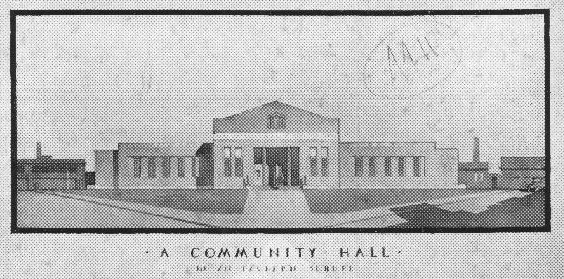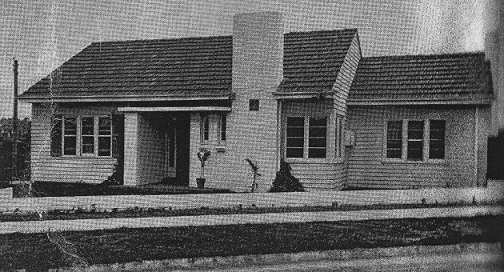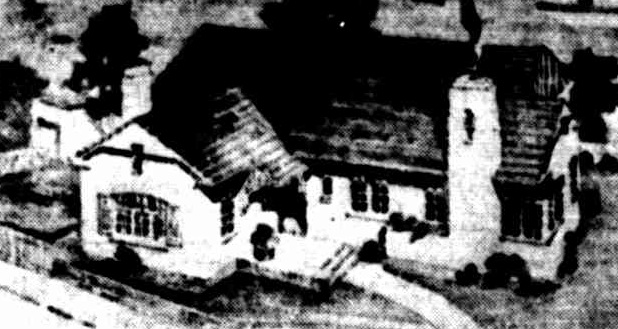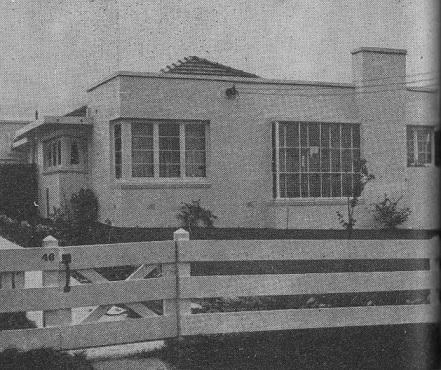Charles
Victor Boyd Dumbrell was born in Albury, NSW, in 1906. In order
to distinguish himself from his similarly-named father, Charles Raymond
Dumbrell (1869-1950), he generally referred to himself as either C
Victor Dumbrell or simply C V B Dumbrell. He commenced his
architectural career in March 1925 as an articled pupil of Eric Beedham
(1895-1947), a young Tasmanian-born architect who had then only
recently commenced private practice in Melbourne. After completing his
articles in March 1929, Dumbrell remained in Beedham's office as a
draftsman until the end of 1930. During that period, Dumbrell
also took evening classes in Architecture and Building Construction at
the Melbourne Technical College (now RMIT) and studied at the
University of Melbourne Architectural Atelier, where he completed his
Diploma of Architectural Design in 1931. As former employer Eric
Beedham later noted in a written testimonial, Dumbrell "completed this
university studies with distinction". During his final two years
at the atelier, he won no fewer than three awards: the Oakley Sketching
Prize (1930), the Grice Bronze Medal (1931) and the Perrott Prize for
Architectural Rendering (1931). Two of his student projects were
also published in the Atelier's annual bulletin in 1931 and 1932.
By the time that he completed his university studies, Dumbrell had left the office of Eric Beedham and was working as a draftsman for R M & M H King. In May 1934, he passed his examinations for admission to the RVIA and, by the following year, had opened his own architectural office. One of his first projects was a house in Kew for businessman Alec Pratt, for which tenders were called in July 1935. Five months later, the eye-catching Tudor R revival dwelling was published in the Australian Home Beautiful. It appears that Dumbrell originally practised from his own residence in Oulton Street, Caulfield; within a year, however, he had transferred his business to an inner city address, on the fifth floor of Miller House at 357 Little Collins Street. Dumbrell's subsequent practice concentrated on small-scale residential projects in the inner eastern and south-eastern suburbs, many of which were published in journals and the weekly property columns of daily newspapers. Like most Melbourne architects of the period, he worked in a broad range of fashionable historicist styles, but seems to have had a particular fondness for the Georgian Revival and Tudor Revival modes. In January 1937, Dumbrell was admitted as an associate of the RVIA.
After the Second World War, Dumbrell moved from Caulfield into a new house that he had designed for himself and his family in Balwyn. Although he maintained his professional offices in central Melbourne, the focus of his practice subsequently shifted to the eastern suburbs in the vicinity of where he lived (ie Balwyn, Balwyn North, Glen Iris). During these years, Dumbrell also began to undertake an increasing number of non-residential projects, including small factory and commercial complexes. In the mid-1950s, Dumbrell entered into partnership with D F Cowell Ham, an architect who specialised in theatre and hotel design. Their staff included a young Polish emigre, Helen Holgar, who would later establish (together with her husband John) the prominent and successful architectural partnership of Holgar & Holgar.
In 1963, Dumbrell was elevated to Fellowship of the RAIA "in recognition of this contribution to the advancement of the architectural profession". He died three years later, on 28 April 1966, at the age of 59 years, and was interred at Eltham Cemetery. His eldest daughter, Lesley Dumbrell (born 1941), became an abstract artist of considerable reputation, holding no fewer than 27 solo exhibitions across Australia between 1969 and 2010.
By the time that he completed his university studies, Dumbrell had left the office of Eric Beedham and was working as a draftsman for R M & M H King. In May 1934, he passed his examinations for admission to the RVIA and, by the following year, had opened his own architectural office. One of his first projects was a house in Kew for businessman Alec Pratt, for which tenders were called in July 1935. Five months later, the eye-catching Tudor R revival dwelling was published in the Australian Home Beautiful. It appears that Dumbrell originally practised from his own residence in Oulton Street, Caulfield; within a year, however, he had transferred his business to an inner city address, on the fifth floor of Miller House at 357 Little Collins Street. Dumbrell's subsequent practice concentrated on small-scale residential projects in the inner eastern and south-eastern suburbs, many of which were published in journals and the weekly property columns of daily newspapers. Like most Melbourne architects of the period, he worked in a broad range of fashionable historicist styles, but seems to have had a particular fondness for the Georgian Revival and Tudor Revival modes. In January 1937, Dumbrell was admitted as an associate of the RVIA.
After the Second World War, Dumbrell moved from Caulfield into a new house that he had designed for himself and his family in Balwyn. Although he maintained his professional offices in central Melbourne, the focus of his practice subsequently shifted to the eastern suburbs in the vicinity of where he lived (ie Balwyn, Balwyn North, Glen Iris). During these years, Dumbrell also began to undertake an increasing number of non-residential projects, including small factory and commercial complexes. In the mid-1950s, Dumbrell entered into partnership with D F Cowell Ham, an architect who specialised in theatre and hotel design. Their staff included a young Polish emigre, Helen Holgar, who would later establish (together with her husband John) the prominent and successful architectural partnership of Holgar & Holgar.
In 1963, Dumbrell was elevated to Fellowship of the RAIA "in recognition of this contribution to the advancement of the architectural profession". He died three years later, on 28 April 1966, at the age of 59 years, and was interred at Eltham Cemetery. His eldest daughter, Lesley Dumbrell (born 1941), became an abstract artist of considerable reputation, holding no fewer than 27 solo exhibitions across Australia between 1969 and 2010.
Select List of Projects
| 1935 1936 1937 1938 1948? 1950? 1952 1953 1956 undated | Residence for A C Pratt (Balgownie), Howard Street, Kew Residence, Constance Street, Hawthorn Residence, Maleela Avenue, Balwyn Residence for Mrs L B Marshall, 40 Carlsberg Road, Heidelberg Residence for Miss E S Wood, 369 North Road, Caulfield Residence, Hartwell Residence, Walbundry Avenue, Balwyn Residence for self, 55 Yerrin Street, Balwyn Factory for Glazebrook Paints Pty Ltd, 269 Williamstown Road, Port Melbourne Residence for D W Griffiths, 46 Greythorn Road, Balwyn North [demolished] Office building for Blue Cross Health & Insurance Society, Burke Road, Glen Iris Shopping arcade, Whitehorse Road, Ringwood Metung Hotel, Metung [in association with D F Cowell Ham] Residence, 25 Fairview Street, Hawthorn Flats, Whitehorse Road, Balwyn |
 | |
| Dumbrell's Atelier project for a Community Hall (1931) |
 | |
| Unidentified residence, Hartwell (1937) |
 | |
| E S Wood Residence, North Road, Caulfield (1937) |
 | |
| Griffiths Residence, Greythorn Road, Balwyn North (1952) |
 | |
| Metung Hotel (in association with D F Cowell Ham) |
